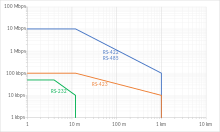RS-423
| RS423 | |
|---|---|
| Standard | EIA RS-423 |
| Physical Media | Group of copper cables |
| Network Topology | Point-to-point, Multi-dropped |
| Maximum Devices | 10 (1 driver & 10 receivers) |
| Maximum Distance | 1200 meters (4000 feet) |
| Mode of Operation | Single-ended (unbalanced) |
| Maximum Baud Rate | Up to 100kbit/s |
| Voltage Levels | -6V to +6V (maximum) |
| Mark(1) | -4V to -6V |
| Space(0) | +4V to +6V |
| Available Signals | Tx, Rx, GND |
| Connector types | Not specified |
RS-423, also known as TIA/EIA-423, is a technical standard originated by the Electronic Industries Alliance that specifies electrical characteristics of a digital signaling circuit. Although it was originally intended as a successor to RS-232C offering greater cable lengths, it is not widely used.
RS-423 systems can transmit data on cables as long as 1,200 meters (3,900 ft).[dubious ] It is closely related to RS-422, which used the same signaling systems but on a different wiring arrangement: RS-423 differed primarily in that it had a single return pin instead of one for each data pin.[1]
RS-423 specifies an unbalanced (single-ended) interface, similar to RS-232, with a single, unidirectional sending driver, and allowing for up to 10 receivers.[2] It is normally implemented in integrated circuit technology and can also be employed for the interchange of serial binary signals between DTE & DCE.
Standard scope[edit]
RS-423 is the common short form title of American National Standards Institute (ANSI) standard ANSI/TIA/EIA-423-B Electrical Characteristics of Unbalanced Voltage Digital Interface Circuits and its international equivalent ITU-T Recommendation T-REC-V.10,[3] also known as X.26. These technical standards specify the electrical characteristics of the unbalanced voltage digital interface circuit.[4] RS-423 provides for data transmission, using unbalanced or single-ended signals, with unidirectional/non-reversible, terminated or non-terminated transmission lines, point to point, or multi-drop.
Characteristics[edit]

RS-423 is closely related to the RS-422 standard, both of which use the same overall signaling system, but differ in that RS-422 has a dedicated return line for every data pin, while RS-423 uses a single return line. Use of a common ground is one weakness of RS-423 (and RS-232): if devices are far enough apart or on separate power systems, the ground will degrade between them and communications will fail, resulting in a condition that is difficult to trace.[5]
RS-423 specifies the electrical characteristics of a single unbalanced signal. The standard was written to be referenced by other standards that specify the complete DTE/DCE interface for applications which require a unbalanced voltage circuit to transmit data.[citation needed]
These other standards would define protocols, connectors, pin assignments and functions. Standards such as EIA-530 (DB-25 connector) and EIA-449 (DC-37 connector) use RS-423 electrical signals.[citation needed]
Applications[edit]
The BBC Micro computer uses RS-423 with a 5-pin DIN connector. DEC used it extensively with a Modified Modular Jack connector. This was sometimes called "DEC-423".[citation needed]
See also[edit]
References[edit]
- ^ "EIA-423". foldoc.org. Retrieved 2021-07-08.
- ^ Buchanan W.J. (2004) RS-422, RS-423 and RS-485. In: The Handbook of Data Communications and Networks. Springer, Boston, MA.ISBN 978-1-4757-1067-0 page 627
- ^ "V.10 : Electrical characteristics for unbalanced double-current interchange circuits operating at data signalling rates nominally up to 100 kbit/s". itu.int. Retrieved 3 May 2023.
- ^ TIA/EIA STANDARD, Electrical Characteristics of Unbalanced Voltage Digital Interface Circuits, TIA/EIA-423-B, May 1993
- ^ National Semiconductor Application Note AN-1031 "TIA/EIA-422-B Overview", January 2000, National Semiconductor Inc. page 2 - evaluate the combination of cable length and data rate.
